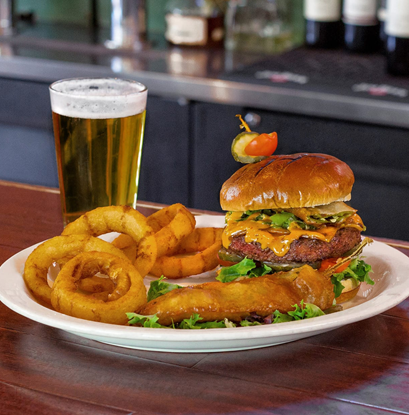Follow our complete, step-by-step, photo illustrated instructions to learn how to make these Italian Dressing marinated Chicken Strips in your own kitchen. Printable recipe included.

Chicken Strips were on the menu at my brother’s restaurant many years ago. They were very popular, and for good reason. Marinating fresh chicken tenderloins in Italian Dressing really provides a great flavor.

Back in 1987, my older brother opened a restaurant called “Captain Gordon’s Seafood.” I guess you can tell it was a seafood restaurant. Smile.
Since not everyone likes to eat seafood, you always make some other items available on the menu, so we had hand cut Ribeye Steaks, and these Chicken Strips as alternatives. The kids loved them, but we sold a good number of them to the adults as well.
We used fresh chicken tenderloins, marinated in Italian Dressing, then coated them in flour and deep fried them. As I recall, we sold plates of 3 strips and plates of 5 strips each. They were generally served with Cole Slaw, and French Fries or a Baked Potato. Customers always had a basket of hushpuppies delivered to the table once they placed an order.
I keep saying “we.” It was my brother’s restaurant. I helped him set it all up, created the menu, and then managed the kitchen for about 2 years after it opened. I’ve said it before, but working in that restaurant was some of the hardest work I’ve ever done. Don’t judge me. When it gets up to 115F degrees in the kitchen, it’s hot. We never did seem to be able to keep it cool enough.
Chicken Strips are very easy to make. I do hope you’ll try them. And, when you do, be sure to come back and leave us a Comment in the section below to let me know how they turned out for you. I always enjoy reading your Comments.
Ready to give our recipe a try? Alright then, let’s head on out to the kitchen, and… Let’s Get Cooking!

Chicken Strips Recipe – You’ll need these ingredients.
I’m using chicken tenderloins, like we did at the restaurant. You could also use boneless chicken breasts if needed. Slice it into strips, then pound it flat with a mallet before placing it in the marinade.

No need to rinse these, we’ll use them straight from the package.
This has been fairly hard for me to wrap my head around, but these days, sources say there is less chance of cross contamination if you just skip rinsing chicken and use it straight from the package.
I never would have done this, even back when we started posting recipes on the Internet, but I’ve adopted the practice lately. Guess you can still teach and old dog a new trick every now and then. Smile.
Food safety is always of the utmost importance when in the kitchen.

Place all the chicken tenderloins in a Ziplock type plastic bag.
You could also use a glass dish, or a stainless steel pan. I’d avoid using anything plastic because you’ll never get the smell of the Italian Dressing out of it afterwards. Just saying.

Add enough of the Italian Dressing to fully coat all the chicken tenders. Don’t skimp on this, they will soak it up pretty good, so add plenty.
Close the bag, then toss the chicken tenders around in the dressing to fully coat them all.

Refrigerate the chicken tenders overnight, or longer if possible.
I like to leave mine for about 48 hours if possible. But, a good 24 hours will work well.

When you’re ready to start frying them, setup your dredging station.
I’ve placed about 2 cups of self-rising flour in a small container. I added 1 teaspoon of Salt and 1 teaspoon of Black Pepper to the flour, then stirred it up really good. I’ve placed the biggest part of the can of milk in another container.
I prefer the Evaporated Milk. It’s what we used at the restaurant. Whole milk would work, and so would All-Purpose Flour if that’s all you have on hand.

Remove one of the chicken tenders and place it in the flour. Can you see how it’s absorbed the Italian Dressing?

Coat the chicken tender well with flour. Then shake off any excess.

Place the coated tender in the milk. Coat it well.

Remove from milk, drain off any excess milk.

Dip the strip back into the flour. Coat both sides well. Then, shake off the excess flour.

Place the strips on a plate or some parchment paper and let them dry a bit while you heat up the oil in your skillet.

I filled my cast iron skillet about half full with Canola Oil once the pan was hot. Let the oil heat up to about 350F degrees so it will be hot enough to fry the tenders.
Place one or two tenders in the hot oil and fry them. It’s best to get the temp adjusted on the oil before you add more to the pan. They should cook about 2 to 3 minutes on each side.
What I’m not going to show you is the first couple of tenders that I burned because the oil was too hot when I added them. They got really dark on the outside before the inside was done. So, follow my suggestion and just cook one or two of them first to be sure you have the temperature right. You can thank me later.

Flip them over after about 2 to 3 minutes and let them fry until done.
I used a digital thermometer to check mine. The internal temperature should be 165F degrees. I had to take them out of the skillet to check them to be sure. I’d drop them back in if they weren’t done.
You can also watch for the sizzle in the pan to slow down as they are about done. But, again, safety is of the most importance. If you don’t have a digital thermometer, you can pick up one for less than $10.00 in lots of stores. It’s a valuable tool to have in your kitchen.
When they are done, remove them from the oil and place on a metal sheet pan or plate to cool and rest for a couple of minutes.
Continue to fry the remaining strips. Don’t crowd the pan, they need a little space around them so they will cook more evenly.

Enjoy!



